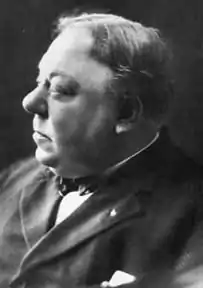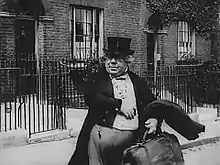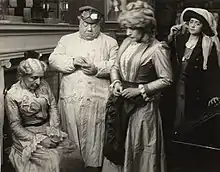John Bunny
John Bunny (September 21, 1863 – April 26, 1915) was an American actor. Bunny began his career as a stage actor, but transitioned to a film career after joining Vitagraph Studios around 1910. At Vitagraph, Bunny made over 150 short films – many of them domestic comedies with the comedian Flora Finch – and became one of the most well-known actors of his era.
John Bunny | |
|---|---|
 | |
| Born | September 21, 1863 New York, New York, U.S. |
| Died | April 26, 1915 (aged 51) New York, New York, U.S. |
| Occupation | Actor |
| Spouse(s) | Clara Scanlan (m. 1890)[1] |
| Relatives | George Bunny (brother) |
Life and career
Bunny was born in Brooklyn, New York and educated in New York public schools. The son of an English father and an Irish mother, he initially worked as a clerk in a general store before joining a small minstrel show at the age of twenty.[2] In a stage career spanning twenty-five years, Bunny worked for a number of touring and stock theater companies, with stints in Portland, Seattle, and various cities on the east coast.[3] Bunny eventually worked his way into Broadway, where he was in productions such as Aunt Hannah (1900), Easy Dawson (1905), and the Astor Theatre's inaugural production of A Midsummer Night's Dream (1906), where his performance as Bottom garnered acclaim.[4][5]
In a 1915 interview, Bunny recounted how he decided to enter the film industry after determining that "it was the 'movies' that were the main cause of the lean times on stage." Bunny offered his services to Vitagraph Studios, but was refused a job because the studio manager believed he could not offer Bunny a high enough salary.[6] Bunny, however, insisted on taking the lower pay and began working at Vitagraph Studios around 1910,[7] where he went on to star in over 150 films. At Vitagraph, Bunny was often paired with the comedian Flora Finch, with whom he made many popular comedies – often featuring situational humor in a domestic setting, in contrast with the rowdier slapstick style used in some films at the time – that came to be known as "Bunnygraphs" or "Bunnyfinches".[8][9] According to the Library of Congress, the Bunnygraph genre was exemplified by A Cure for Pokeritis (1912),[8] which features the efforts of a wife to put a stop to her husband's gambling habit by organizing a fake police raid on his weekly poker game.


Regarding a career as a film actor, Bunny said:[10]
There's nothing like it. No other work gives an actor or would-be actor the same advantages. In the pictures, a player gets fifty-two weeks in the year. Where is the theatrical manager who can offer that? Not even vaudeville stars can get such bookings. At best, thirty weeks is about all an actor can expect on the stage. He may get summer stock work, but even so it is of uncertain duration. Stage work is a gamble. Even when you have been engaged for a production, rehearsed from three to six weeks without pay, and no doubt bought your own costumes for the piece, you have no guarantee that it will be a success. If the public does not set its stamp of approval, your job is all over perhaps after but one performance, and you can only repeat the procedure by trying again with someone else, charging the other to your loss account, with a credit notation probably on the page marked 'experience.'
Bunny had been acting in films for only five years when he died from Bright's disease at his home in Brooklyn on April 26, 1915.[11] He was survived by his wife and two sons and interred in the Cemetery of the Evergreens in Brooklyn, New York.[12]
Reception and legacy
Bunny was one of the most well known film actors of his lifetime. A New York Times editorial published after Bunny's death noted that thousands recognized him as "the living symbol of wholesome merriment", and declared: "Wherever movies are exhibited, and that is everywhere, Bunny had his public. It is perfectly safe to say that no other camera actor was as popular in this country."[13] The actress Frances Agnew wrote in 1913 that "Mr. Bunny's name is a household word, not only from coast to coast in America, but also in every city and town in the world at all acquainted with the 'movies'".[14] An article published in London's Daily News recounted the enthusiastic reception Bunny received while filming The Pickwick Papers in England and how his fame was such that a heavy-set member of King George V's entourage was mistaken for the actor while the King was visiting Scotland.[15]
Bunny's skills as an actor were praised by his contemporaries. In particular, his ability to convey emotion without the use of words drew comment from critics. John Palmer of the Saturday Review declared, "Mr. Bunny has an extensive and extremely flexible face. ... We know at once why Mr. Bunny never speaks. He could not possibly find words to convey the extremity of his feelings."[16] According to The New York World, "The advent of the film drama found [Bunny] particularly well endowed for the new art of acting without words. The range of his facial expression was altogether wonderful, and when the emotion of the moment had told its story in his features there was nothing left for the words to do."[17] The poet and writer Joyce Kilmer wrote glowingly of Bunny's acting ability, and claimed that Bunny was responsible for reviving the art of pantomime.[18]
A 1916 Washington Times article claimed: "To John Bunny ... must be given the credit of presenting the first bits of refined comedy in photoplay. Previous to his advent into screenland film comedies were either "chases" or grotesque trick photography. He rescued screen humor from the chamber of horrors and placed it in the hall of fame".[19] In the words of his contemporary Henry Lanier, Bunny demonstrated "that a real actor can make an incredible success before [a film] audience without any of the vulgarity or horseplay which used to be considered essential."[20] This assessment is echoed by the modern film scholar Wes Gehring, who writes that "Bunny helped elevate at the time what was still often considered a second-class medium to a level of artistic significance".[21]
According to Frank Scheide, Bunny's films might have been taken more seriously because "Bunny's humor was based more on comedy of manners than slapstick", a "polite" and "respectable" form of situational comedy in contrast to the "decidedly lowbrow, crass, and often violent" humor of slapstick films.[22] According to Gehring, Bunny was "the first in a long line of American personality screen comedians", whose approach is marked by a "subordination of story to character".[23] The personality focus of Bunny's films was also noted by the screenwriter Catherine Carr, who wrote in 1914: "In most big companies at the present day there are maintained actors around whose personality comedies are being written; i.e., John Bunny, Flora Finch, etc. These actors take the mere germ of a comedy and develop it through their clever acting into a screen production that brings laughter wherever it is shown."[24] Modern viewers may not find Bunny's films as funny as Carr described, however. The film scholar Anthony Slide, for instance, writes that Bunny's "characterizations contain nothing creative, and he uses no knockabout or slapstick comedy. His comedy is all very middle class and very polite. Often so dull is the storyline that the comedy is difficult to uncover. Time and again one wonders if audiences ever did laugh at his work, and, if so, why?"[25]
Despite his genial on-screen persona, Bunny was disliked by some of his fellow actors at Vitagraph. Bunny and Finch "cordially hated each other" according to Vitagraph's co-founder Albert E. Smith,[26] and interviews of former Vitagraph personnel revealed that some found him to be arrogant and difficult to work with.[27]
Following Bunny's passing, new comedic stars came to the fore in silent film and Bunny faded into obscurity. However, he was posthumously inducted into the Hollywood Walk of Fame in 1960 (though he made most of his movies in the East) for his contributions to the film industry with a motion pictures star located at 1715 Vine Street in Hollywood.[28]
Bunny's 1914 vehicle Pigs Is Pigs was preserved by the Academy Film Archive in 2010.[29]
Selected filmography
| Year | Film | Role | Notes |
|---|---|---|---|
| 1909 | Cohen's Dream | Cohen | Alternative title: Cohen's Dream of Coney Island |
| Cohen at Coney Island | Cohen | ||
| 1910 | Davy Jones and Captain Bragg | Captain Bragg | |
| Captain Barnacle's Chaperone | Captain Barnacle | ||
| 1911 | A Queen for a Day | Bridget McSweeney | |
| Teaching McFadden to Waltz | McFadden | ||
| Her Crowning Glory | Mortimer | ||
| Little Nemo | Partially animated short created by Winsor McCay | ||
| His Sister's Children | |||
| 1912 | Captain Jenks' Dilemma | Captain Jenks | |
| A Cure for Pokeritis | George Brown | ||
| Michael McShane, Matchmaker | Michael McShane | ||
| 1913 | Seeing Double | Binks | |
| Flaming Hearts | Jonathan Whippletree | ||
| The Pickwick Papers | Mr Pickwick | ||
| Bunny Dips Into Society | Bunny | ||
| Bunny as a Reporter | Bunny | ||
| 1914 | Love's Old Dream | Professor Simon Sweet | |
| Setting the Style | Mr. Finnegan | ||
| Hearts and Diamonds | Widower Tupper | ||
| 1915 | The Jarrs Visit Arcadia | ||
Notes
- Vazzana 2001, p. 69.
- "John Bunny's Face Known in Every Corner of Earth Where Films are Seen". The Washington Times. April 16, 1915. p. 13. Bunny's obituary in The Oregonian says his first stage role was at nineteen. See "John Bunny Succumbs". The Morning Oregonian. April 27, 1915. p. 3.
- Eric L. Flom (2009). Silent Film Stars on the Stages of Seattle: A History of Performances by Hollywood Notables. McFarland. p. 105. ISBN 978-0-7864-3908-9.
- Frank Cullen; Florence Hackman; Donald McNeilly (2007). Vaudeville Old & New: An Encyclopedia of Variety Performances in America. Routledge. p. 157. ISBN 978-0-415-93853-2.
- For a review of Bunny's performance at the Astor, see "Astor Theatre Opens with Lovely Spectacle". The New York Times. September 22, 1906. p. 7.
- Lanier 1915, pp. 567–574. For another interview in which Bunny describes his entrance into the film industry, see Agnew 1913, pp. 98–100.
- Sources disagree on the exact date Bunny began working for the Vitagraph Company. As summarized by Anthony Slide, "There is considerable question not only as to why [Bunny chose to work at] Vitagraph, but also as to when. According to William Basil Courtney, Bunny's name first appeared on the Vitagraph payroll on October 27, 1910. Albert E. Smith claims Bunny's first Vitagraph film was Doctor Cupid, released on January 10, 1911. Historian and archivist Sam Gill, who has undertaken extensive research into John Bunny's career, believes that his first screen appearance was in Jack Fat and Jim Slim at Coney Island, released on December 2, 1910. The only subject on which there is general agreement is Bunny's initial salary—$40.00 a week" (Slide & Gevinson 1987, p. 47).
- "2011 National Film Registry More Than a Box of Chocolates" (Press release). News from the Library of Congress. December 28, 2011. ISSN 0731-3527. Archived from the original on November 14, 2017.
- Donald W. McCaffrey; Christopher P. Jacobs (1999). Guide to the Silent Years of American Cinema. Greenwood Publishing Group. pp. 59, 121. ISBN 0-313-30345-2.
- Agnew 1913, p. 96.
- "John Bunny Dies; Movie Funmaker: Fat, Big, Round-Faced Actor Who Made Millions Laugh Succumbs at 52". The New York Times. April 27, 1915. p. 13.
- "Throng at Bunny Funeral: Film and Legitimate Stage Actors Attend Services at Elks' Club". The New York Times. April 29, 1915. p. 14.
- "The Loss of Bunny". The New York Times. April 27, 1915. p. 12.
- Agnew 1913, p. 95.
- The article was sent in a special cable to The New York Times and quoted in "Loved Bunny in Britain: Movie Funny Man Once Wept Over Dockers' Ovation". The New York Times. April 29, 1915. p. 14.
- John Palmer (April 11, 1914). "Mr. Bunny". The Saturday Review. p. 466.
- Quoted in "Death of John Bunny". The Moving Picture World. May 8, 1915. p. 876.
- Joyce Kilmer (May 2, 1915). "Pantomime Revived by John Bunny: Art of Silent Comedy, After a Lapse of Centuries, Appears in Moving Pictures of Famous Actor Who Died Last Week". The New York Times. p. SM15.
- "Another John Bunny in Film". The Washington Times. April 7, 1916. p. 6.
- Lanier 1915, p. 577.
- Gehring 1995, p. 122.
- Andrew Horton; Joanna E. Rapf, eds. (2012). A Companion to Film Comedy. Wiley. pp. 29, 44. ISBN 978-1-4443-3859-1.
- Gehring 1995, p. 121.
-
- Catherine Carr (1914). The Art of Photoplay Writing. New York: Hannis Jordan Company. p. 27. OCLC 7440949.
- Slide 2002, p. 59.
- Quoted in Slide 2002, p. 59. Slide says he found this quote in the unpublished manuscript of Smith's memoirs, Two Reels and a Crank.
- Slide & Gevinson 1987, p. 44.
- "John Bunny | Hollywood Walk of Fame". Hollywood Chamber of Commerce. Archived from the original on February 23, 2018.
- "Preserved Projects". Academy Film Archive.
References
- Agnew, Frances (1913). Motion Picture Acting. New York: Reliance Newspaper Syndicate. OCLC 892525393.
- Gehring, Wes D. (1995). "John Bunny: America's First Important Film Comedian". Literature/Film Quarterly. 23 (2): 120–124.
- Lanier, Henry Wysham (March 1915). "The Coquelin Of The Movies". The World's Work. Vol. 29 no. 5. pp. 567–577.
- Slide, Anthony (2002). Silent Players: A Biographical and Autobiographical Study of 100 Silent Film Actors and Actresses. University Press of Kentucky. ISBN 0-8131-2249-X.
- Slide, Anthony; Gevinson, Alan (1987). The Big V: A History of the Vitagraph Company (revised ed.). Scarecrow Press. ISBN 0-8108-2030-7.
- Vazzana, Eugene Michael (2001). Silent Film Necrology (2nd ed.). McFarland. ISBN 0-7864-1059-0.
Further reading
- Dunham, Harold (Winter 1968–69). "John Bunny". The Silent Picture. No. 1. Unpaged.
- Gill, Sam (Summer 1972). "John Bunny: A filmography compiled by Sam Gill". The Silent Picture. No. 15. pp. 8–15.
- "John Bunny Show". Variety. March 19, 1915. p. 16.
- Lahue, Kalton C. (1966). World of Laughter: The Motion Picture Comedy Short, 1910–1930. Norman: University of Oklahoma Press. OCLC 246244278.
- Smith, Albert E. (1952). Two Reels and a Crank. New York: Doubleday & Company. OCLC 586891.
External links
| Wikimedia Commons has media related to John Bunny. |
